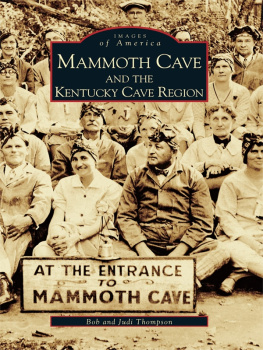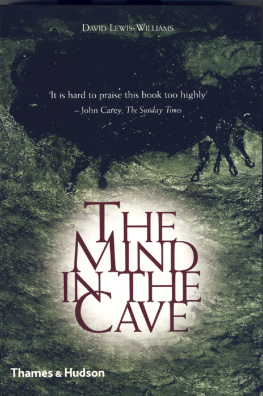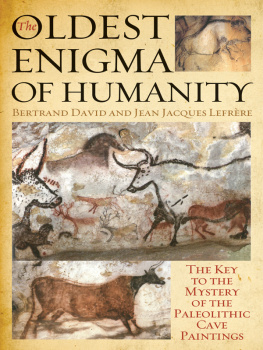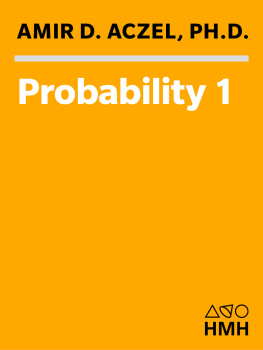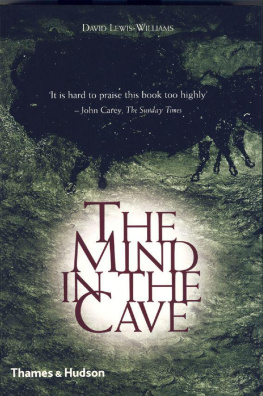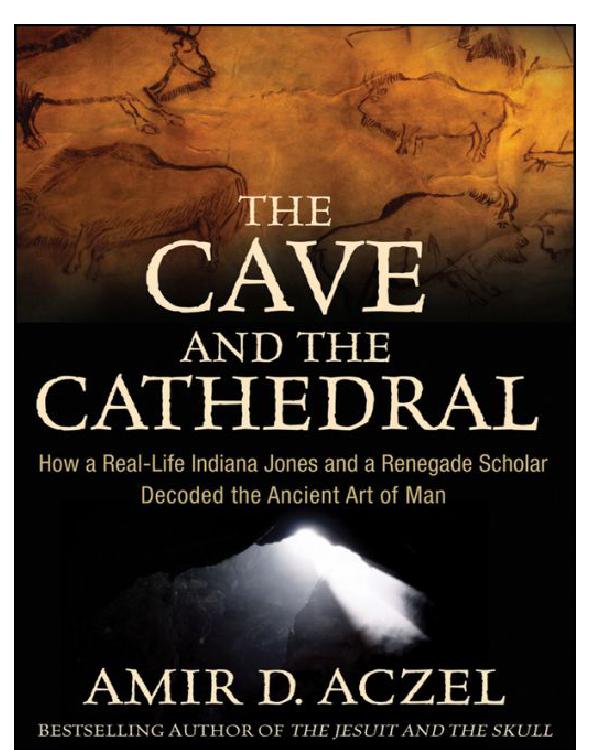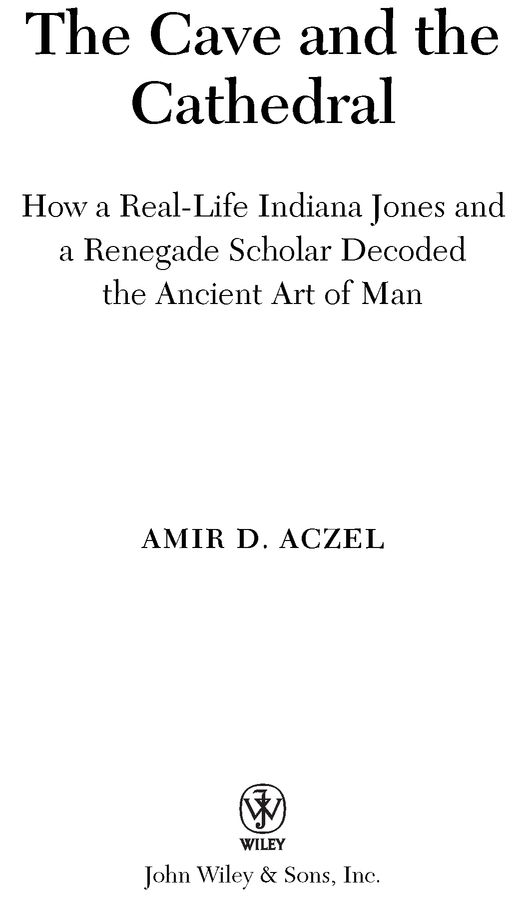Table of Contents
Books by Amir Aczel
The Jesuit and the Skull: Teilhard de Chardin, Evolution,
and the Search of Peking Man
The Artist nd the Mathematician: The Story of
Nicola Bourbaki, the Genius Mathematician
Who Never Existed
Descartess Secret Notebook: A True Tale of
Mathematics, Mysticism, and the Quest to Understand
the Universe
Chance: A Guide to Gambling, Love, the Stock Market,
and Just About Everything Else
Entanglement: The Greatest Mystery in Physics
Pendulum: Leon Foucault and the Triumph of Science
The Riddle of the Compass: The Invention That Changed
the World
The Mystery of the Aleph: Mathematics, the Kabbalah, and
the Search for Infinity
Gods Equation: Einstein, Relativity, and the Expanding
Universe
Fermats Last Theorem: Unlocking the Secret of an Ancient
Mathematical Problem
This book is printed on acid-free paper.

Copyright 2009 by Amir D. Aczel. All rights reserved
Published by John Wiley & Sons, Inc., Hoboken, New Jersey
Published simultaneously in Canada
No part of this publication may be reproduced, stored in a retrieval system, or transmitted in any form or by any means, electronic, mechanical, photocopying, recording, scanning, or otherwise, except as permitted under Section 107 or 108 of the 1976 United States Copyright Act, without either the prior written permission of the Publisher, or authorization through payment of the appropriate per-copy fee to the Copyright Clearance Center, 222 Rosewood Drive, Danvers, MA 01923, (978) 750-8400, fax (978) 646--8600, or on the web at www.copyright.com. Requests to the Publisher for permission should be addressed to the Permissions Department, John Wiley & Sons, Inc., 111 River Street, Hoboken, NJ 07030, (201) 748-6011, fax (201) 748-6008, or online at http://www.wiley.com/go/permissions.
Limit of Liability/Disclaimer of Warranty: While the publisher and the author have used their best efforts in preparing this book, they make no representations or warranties with respect to the accuracy or completeness of the contents of this book and specifically disclaim any implied warranties of merchantability or fitness for a particular purpose. No warranty may be created or extended by sales representatives or written sales materials. The advice and strategies contained herein may not be suitable for your situation. You should consult with a professional where appropriate. Neither the publisher nor the author shall be liable for any loss of profit or any other commercial damages, including but not limited to special, incidental, consequential, or other damages.
For general information about our other products and services, please contact our Customer Care Department within the United States at (800) 762-2974, outside the United States at (317) 572-3993 or fax (317) 572-4002.
Wiley also publishes its books in a variety of electronic formats. Some content that appears in print may not be available in electronic books. For more information about Wiley products, visit our web site at www.wiley.com.
Library of Congress Cataloging-in-Publication Data:
Aczel, Amir D.
The cave and the cathedral: how a real-life Indiana Jones and a renegade scholar decoded the ancient art of man / Amir D. Aczel.
p. cm.
Includes bibliographical references and index.
eISBN : 978-0-470-63811-8
1. Paleolithic period. 2. Magdalenian culture. 3. Cave paintings.
4. Painting, Prehistoric 5. Niaux Cave (France) 6. Lascaux Cave (France)
7. Chauvet Cave (France) 8. Antiquities, Prehistoric. I. Title.
GN771.A28 2009
930.1-dc22 2009006816
2009006816
To Miriam, who ventured into
the depths of Combarelles
Preface
One of the greatest mysteries of the human experience on Earthif not the greatest mystery of allis the appearance, around 32,000 years ago, of magnificent paintings, drawings, and engravings of animals inside deep and often almost inaccessible recesses of large Ice Age caverns in France and Spain (and a small number of cases in southern Italy). The art seems to have followed very specific norms: It almost exclusively featured animals; there were only a few humanlike figures, never portrayed in as much detail as the animals. There was absolutely no terrainno trees, no rivers, no mountains, no ground whatsoever; the animals appear to be floating in space, and their images often overlap.
Stunningly, this specific practice had remained perfectly unchanged for 20,000 yearsfrom 32,000 years ago until around 12,000 years ago; the art found in all of the decorated caves followed this exact format. Then, around 11,500 years ago, the fecund artistic activity in deep caves inexplicably came to an abrupt end. The mystery of cave art is the question Why?
Why would the Cro-Magnon hunter-gatherers of Europe expend so much time, effort, and resources to penetrate into deep, dark, and dangerous caverns, where they might encounter cave bears and lions or get lost and die? Why would they often crawl on all fours for distances of up to a mile or more underground, over mud and sharp stones, through narrow jagged fissures in the stony entrails of caves, aided only by the dim glow of animal-fat-burning stone candles, to paint amazing, haunting images of animals?
The discovery of the first decorated caves in the 1870s shocked the world. Attempts to solve the mystery of the purpose, the meaning, and perhaps the hidden symbolism of Upper Paleolithic cave art in Europe began after the first decorated caves were discovered in the late nineteenth centurybut these attempts were made only when people became convinced that the art was authentic. (The Paleolithic is the Old Stone Age, lasting from about 2.5 million years ago, roughly when stone tools appearalthough some are even earlier than those and were made by early hominidsto about 11,000 years ago. The latter part, from 45,000 to 11,000 years ago is called the Upper Paleolithic, a period from 45,000 to around 11,000 years ago. Then comes a short intermediate period called the Mesolithic, and it is followed by the Neolithic, or the New Stone Age.) For a long time, they assumed that it had been produced by modern-day artists, perhaps as forgeries made to appear ancient.
The first explanations of cave art were logical deductions people made by extrapolating from beliefs and practices of present-day hunter-gatherer societies, such as the magic of the hunt, shamanism, and sympathetic magic, or drawing animals as a way to induce them to be captured. These early hypotheses were prompted by observations of modern-day hunter-gatherer societies in Africa, Australia, and the Arctic and were supported by the finding that some of the animals depicted in caves (although not many) appeared to be wounded. In addition, in very few cases, the humanlike beings drawn in caves appeared to be wearing animal masks or to have features with animal characteristics, and this reminded scholars of the shamanistic practices of some modern-day societies.



